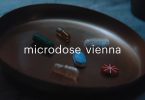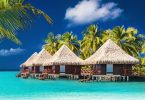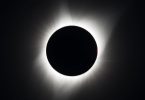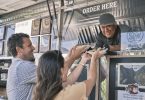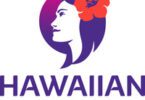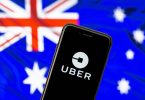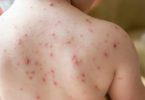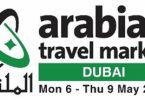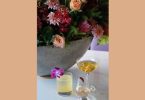Many women will not appear in public with a nude face and there are a growing number of men who are treating their public face to astringents, creams, masks, colors, tubes and pencils. In a May 2017 survey of American consumers, 41 percent or respondents between 30-59 years of age, wear makeup daily, with 25 percent wearing makeup several times a week.
The men’s personal care industry may go as high as $166 billion by 2022 (Allied Market Research). In 2018 the sale of men’s skin-care products increased by 7 percent in sales and the category is valued at $122 million (NPD Group).
The global cosmetics market was valued at $532.43 billion (2017) and is expected to reach a market value of $805.61 billion (2023). The US cosmetic industry is the largest in the world, generating a total revenue of approximately $54.89 billion. In the US, the industry employees over 53,000 people.
Expensed
Some consumers do not consider cosmetic purchases as an expense, placing purchases in their “Investment” category. The largest purchases include: Makeup ($932 million), followed by Skincare ($844 million), and Fragrance sales ($501 million). The major share of market is controlled by Facial skincare (27 percent), followed by Personal care (23 percent), Hair care (20 percent), Makeup (20 percent) and Fragrances (10 percent).
Individual Spend
In a study sponsored by Groupon (conducted OnePoll), it was determined that women routinely spend an average of $3756 a year ($313 a month), or $225,360 between the ages of 18-78 on skincare products. Male respondents spend an average of $2928 per year ($244 per month), totaling $175,680 or about one-fourth (22 percent) less than women during this same time period.
Consumers are selecting their self-care products at Walmart and Target, accounting for 57 percent of purchased skincare products in the last 6 months. Other purchases are transacted at Drugstores ($220 billion), through Spa Services ($13 billion); Department stores ($70 billion), and Cosmetic retailers ($10 billion). The largest beauty brands are Olay ($11.7 billion); Avon ($7.9 billion), L’Oréal ($7.7 billion); Nivea ($5.6 billion).
Major Players
Where established brands (L’Oréal Group, Proctor & Gamble, Beiersdorf AG, Avon Products, Inc., Unilever, The Estee Lauder Companies Inc., Shiseido, Kao Corp., Revlon Inc., Mary Kay Inc., Yves Rocher, Oriflame Cosmetics Global SA and Alticor) continue to expand, younger consumers are rejecting the products used by their parents, and actively buying locally-made, artisanal, natural products in all consumer categories. If the product is also Instagram-able – the more desirable it becomes.
Economics
For the most part, the cosmetic industry is impervious to the expansion / contraction of an economy. Sales may dip during a recession; however, it appears products continue to be purchased no matter what happens on Wall Street. This may be attributed to the fact there is continuing and growing use of products by women and increasingly by men, around the world.
Why do People Wear Makeup?
Over 50 percent of women interviewed stated that wearing makeup made them feel like they were in control, 82 percent indicated it provided them with self-confidence and 86 percent of the women said that wearing makeup improved their self-image.
The aging population is also a reason that the industry continues to prosper. Over the last 2 decades, declining fertility and mortality rates have resulted in a rise in the global aging population. There is a strong desire among men and women to retain a youthful appearance. This rapidly aging demographic has led to a demand for anti-aging products to prevent wrinkles, age spots, dry skin, uneven skin tones and hair damage, motiving manufactures to provide innovative cosmetics.
By 2050, the population over 60 years of age is expected to reach 2.09 billion. The life expectancy for women is predicted to rise from 82.7 years in 2005, to 86.3 years in 2050. For men, the expected increase is from 78.4 to 83.6 years, creating an ever-increasing demand for cosmetics.
Online Sales
While retailers are benefiting from the sale of well-care products (i.e., skin care, hair care and fragrances) most products are sold online. Companies are increasingly focusing on online marketing campaigns that can increase revenues with low investments. The market is seeing a trend of multinational companies establishing website and brand-specific Facebook accounts and Twitter profiles to address local/cultural preferences.
The largest growth markets are expected to be the Middle East (UAE, Saudi Arabia, and Israel) and the African region. UAE is becoming a top priority as it is a country with a high GDP per capita (USD $40,444, 2012) with an administration that is modern, and shows growth potential regarding women in the workplace. As more women become employed, the need to look good, and therefore purchase cosmetics, has increased – not just based on preference.
There is also evidence of increased consumer demand in China, India and Malaysia, which is good news for the industry, as North America is considered a “mature market,” with growth potential focused on new and innovative products.
Trends
Because of consumer demand, there is an increase in the use of natural and organic ingredients in cosmetic products and this market segment is expected to increase to $8.3 billion in market size by 2023. This is good news for manufacturers, as the use of natural ingredients reduces the risk of side effects and ultimately increases the use of cosmetics.
Nail care market growth is also expected as there is an increased awareness among health-conscious consumers that non-toxic and chemical-free offerings are available.
Eye makeup is also growing in demand with a focus on waterproof products, especially desirable during the summer season. Successful products fight humidity and heat without affecting the quality and performance.
Innovators
The cosmetic industry has an exceptionally short lifecycle and manufacturers are constantly improving existing products and exploring opportunities for innovation. Entrepreneurs introducing new products know that the desire for instant-gratification is bigger and bolder than ever, resulting in products that allow consumers to see immediate improvement (i.e., the end of under-eye bags and crows-feet).
Magazines, movies and YouTube videos offer a face that is porcelain-like, completely smooth and perfect…there is nothing natural about the effect. However, the innovators, aware of this “wish,” are offering products that create a flawless appearance along with perfect hairstyles.
Indie Beauty Show
Independent cosmetic manufacturers are pushing the envelope, introducing new and unique well-care products. The Indie Beauty Show is the world’s largest collection of independent beauty companies and they were recently showing their newest products in New York.
Over 240 beauty brands were represented at Pier 94 at the 5th annual Indie Beauty Show. For two days, retail buyers, journalists, bloggers, investors, and other beauty industry professionals met the entrepreneurs responsible for the brands and were encouraged to test the products, doing a deep dive into ingredients, testing methods and anticipated results.
Jillian Wright, an aesthetician, started the Show in 2015 with entrepreneur Nader Naeymi-Rad after identifying the reality that there were brands ready for large markets, but not quite ready for acquisition by existing industry leaders.
The partners recognized that there were almost no opportunities for cosmetic/skincare brands to meet with investors or consumers. Other shows were either too large or too small (i.e., street fairs and farmers markets). They created Indie Beauty Show to fill the gap and now the show is produced in New York as well as Dallas and Los Angeles, London and Berlin.
The project has benefited from, “right place/right time.” Consumers want organic/chemical – free, products and want to know the people making the stuff they are putting on their bodies.
A Curated List
- Lucky Chick. LuckyChic.com
- Cosmetics are free of parabens, mineral oil, phthalates, triclosan, sulfates and gluten.
- Made in New York, safe ingredients include coffee, rose, jojoba oil and cucumber extract. The line includes lip lacquers, creamy matte lipsticks and glazes, in shades ranging from nude to deep plum and shimmery liquid jewel eye shadow.
- Toogga. Toogga.com
- This African based company specializes in producing sustainable, harvested, organic, natural, non-toxic skincare and nutritional products, based on native ingredients sourced from the Sahel region.
- Products include sustainable African balms, butters and oils, healing handmade soaps, hair shampoos and bars, plus Organic Date Desert Oil, Hibiscus Tea Petals and Wild Harvested Baobab Powder.
- The company partners with Trees for the Future, and plants a tree in the Sub-Saharan region of Africa for every product sold.
- RoyeR. maisonroyer.fr
- The is located in Les Herbiers, France.
- Started in 1989 RoyeR Cosmetique uses organic snail slime to fight wrinkles.
- The creams are said to have natural hydrating and repairing properties that are effective as anti-wrinkle and anti-spot actions and exfoliating.
- The ingredients are also alleged to prevent and reduce stretch marks, acne, scars and other skin problems.
- 6IXMAN. 6IXMAN.com
- This Toronto-based brand was started by executives in sales, business intelligence and social media.
- The brand focuses on the real lifestyle of contemporary males, supporting an interest in grooming.
- The products are safe, natural, and biodegradable and include beard, hair, and skin-care, as well as shaving.
- Bellabaci Skin Cupping. universalcompanies.com
- These products enable specialized cupping therapy at home. The plant oils include rosehip, boaboa, and argan.
- Hush Cosmetics. hushcosmetics.com.au
- 2005 Jessica Callahan started a career in the makeup and beauty industry and operated a professional beauty salon from her home.
- 2011 she opened the first HUSH store.
- 2016, Callahan celebrated 20 years in the industry and launched an online store with products that have not been tested on animals and do not contain artificial ingredients.

The Expo

Lucky Chick
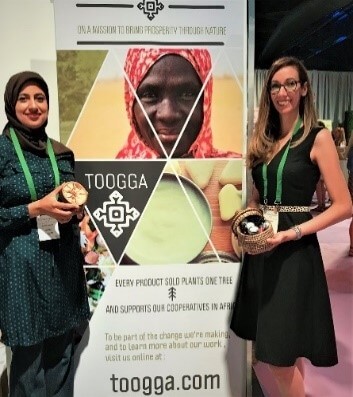
Toogga
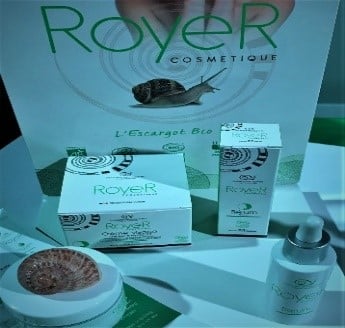
RoyeR Cosmetique
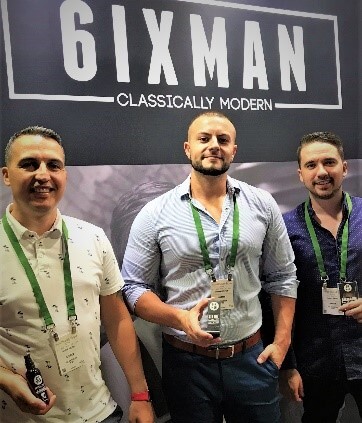
6IXMAN
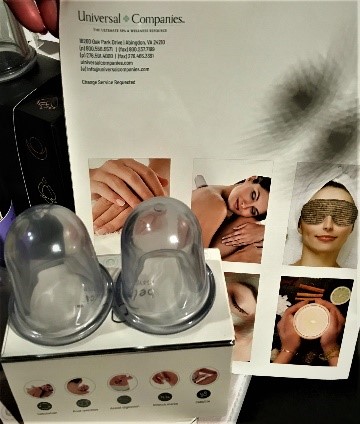
Universal Bellabaci Skin Get-a-Life-Box

© Dr. Elinor Garely. This copyright article, including photos, may not be reproduced without written permission from the author.



